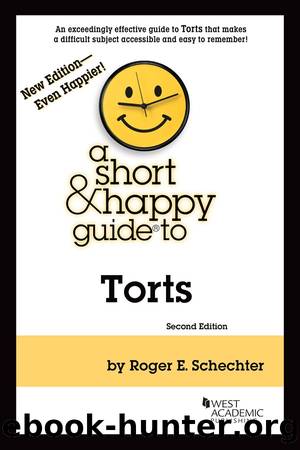A Short & Happy Guide to Torts by Roger E. Schechter

Author:Roger E. Schechter
Language: eng
Format: epub
ISBN: 9781636591100
Publisher: West Academic Publishing
Published: 2021-09-15T00:00:00+00:00
4.Assessing Reasonableness by Considering Costs and Benefits
Reasonable people, supposedly, would be willing to spend a small amount of money or exert a small amount of effort in order to avoid a big harm. On the other hand, reasonable people do not normally spend large amounts of money or exert a great deal of effort to avoid a small or highly unlikely harm. This amounts to nothing more than saying that reasonable people consider the costs and benefits of their actions. It is, among other things, a very 109
popular way to think about âreasonablenessâ among those who are economically oriented.
The most iconic statement of this notion about how to assess or evaluate reasonableness is the so-called Carroll Towing formula, articulated by Judge Learned Hand in the case of that name. In that case he declared that a reasonable person takes a precaution when B < P Ã L, where B is the burden (or cost) of taking that precaution, where P is the probability that an injury will occur without the precaution, and where L is the magnitude of the injury, or loss.
Because the Hand or Carroll Towing formula is rendered as a mathematical equation, it tends to freak out math-phobic law students. An example may serve to make it more concrete. Assume that a customer at a store is mugged on the parking lot. The customer sues the store, alleging that they owed a duty to exercise reasonable care to protect her from a third-party source of harm (the mugger) since she was an invitee on their property, and since harm was foreseeable because there had been others crimes in the neighborhood. To show a breach of this duty she alleges that they should have had better lighting in the parking lot. How does she use the Hand formula to demonstrate that a reasonable store would have invested in the lighting?
Assume that the better lighting would have cost $500. Assume that a survey of other stores reveals that there is a 1% chance of a mugging over the course of a year at stores with lighted parking lots and a 3% chance at stores without lights. Finally, assume that the average mugging inflicts $30,000 in harm (which would include the medical bills and lost wages of victims, any property stolen, and the pain and fear suffered by the victims). The mugging rates reveal that the increased probability of a mugging without the precaution (the lights) is 2%. Multiplying that figure times the loss associated with a mugging yields $600 (in other words 2% of 30,000âif you canât do the math, use your calculator and multiply 30,000 Ã .02). To 110
prevent that loss would have required spending $500 on lights. Since $500 is less than $600, B is less than P Ã L, and a reasonable person would have spent the money on the lights. This means that the store committed a breach of duty by failing to put in lights.
You may be inclined to point out that lights presumably could last for more than one year, but our mugging statistics were yearly numbers.
Download
This site does not store any files on its server. We only index and link to content provided by other sites. Please contact the content providers to delete copyright contents if any and email us, we'll remove relevant links or contents immediately.
The Social Psychology of Inequality by Unknown(2935)
The Plant Paradox by Dr. Steven R. Gundry M.D(2543)
The Writing on the Wall by Anselm Jappe(2006)
Working for Yourself by J.D. (Nolo) Stephen Fishman(1813)
Every Landlord's Legal Guide by Janet Portman & Stewart Marcia & Ralph Warner(1628)
The First 20 Hours: How to Learn Anything ... Fast by Kaufman Josh(1613)
ADHD on Trial by Michael Gordon(1529)
Decisive by Chip Heath(1513)
Working for Yourself by Stephen Fishman J.D. (Nolo)(1476)
Drafting Contracts: How and Why Lawyers Do What They Do, Second Edition by Stark Tina L(1455)
A Practical Guide to International Arbitration in London by Hilary Heilbron(1394)
Restitution by Restitution(1393)
The Economist Aug 8th 2015 by The Economist(1384)
Intellectual Property Strategy by John Palfrey(1383)
The Lord of the Rings: The Fellowship of the Ring, the Two Towers, the Return of the King by J. R. R. Tolkien(1380)
Get What's Yours for Medicare by Philip Moeller(1359)
The Economist Aug 29th 2015 by The Economist(1342)
Collusion by Luke Harding(1281)
Persuasion by Owner(1265)
